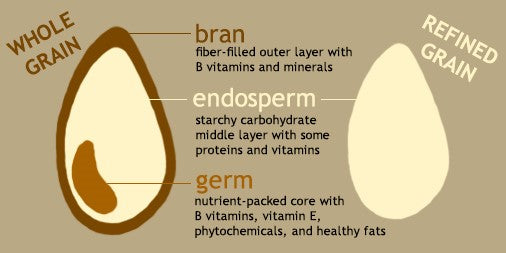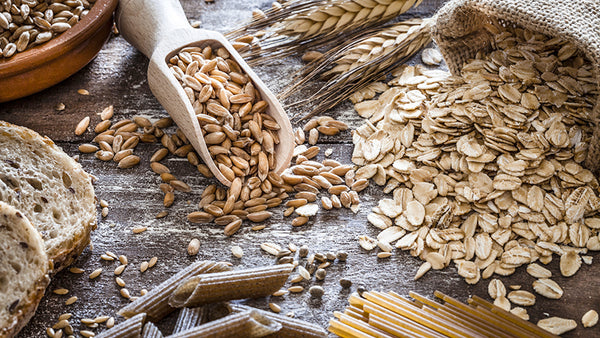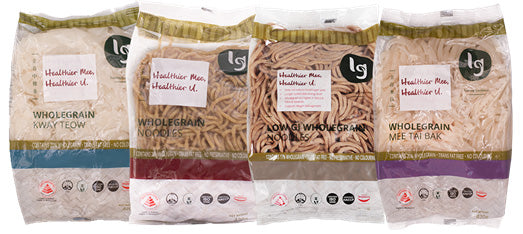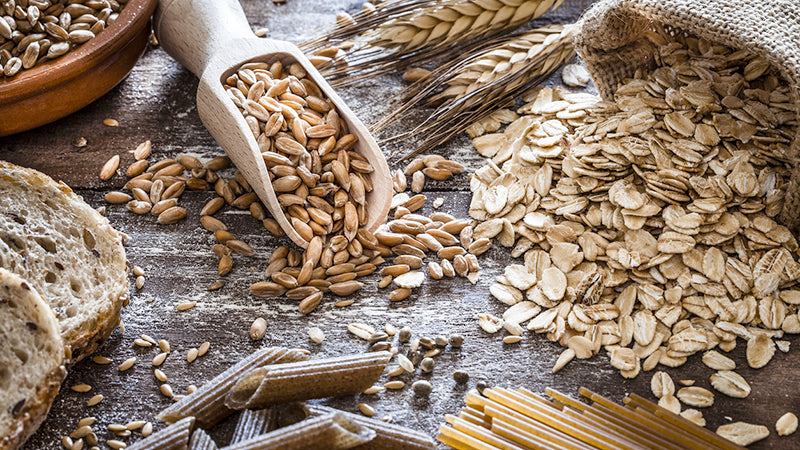What exactly is Wholegrain?
Wholegrain Noodles - The wise selection!
In Leong Guan, we offer a wide variety of wholegrain products ranging from healthy noodles to wholegrain wanton skins. Initially, we managed to obtained only 8% of wholegrain in our products. But right now, we have successfully increased to 20% of wholegrain and reduced levels of sodium which qualifies for higher health claim from Health Promotion Board.
You may have heard a lot about wholegrain and its nutritional values, but how healthy is wholegrain products? Do you really know about them? Find out more in this article!
What is Wholegrain?

Did u know? All wheat grains start life as whole grains. In their natural state growing in the fields, whole grains are the entire seed of a plant. For a whole grain, the husk of the seed is usually maintained or remained intact when growing in the fields, which retained the nutritious benefits of the whole grain. A grain of a seed/kernel contains of 3 parts: The Bran, the Germ and the Endosperm. The seed is protected by an inedible husk that protects the kernel from assaults by sunlight, pests, water, and disease.
The Bran, Germ and Endosperm & its benefits
The wheat bran is the multi-layered outer skin of the edible kernel. It contains important antioxidants, B vitamins and fiber. With 1/4 cup of fiber, it offers 24% of the daily recommended value.
Wheat Germ is a great source of vegetable proteins, along with fiber and healthy fats. It's also a good source of magnesium, zinc, thiamin, folate, potassium, and phosphorus. It is high in vitamin E, an essential nutrient with antioxidant properties.
The Endosperm is the interior layer that holds carbohydrates, protein, and small amounts of some B vitamins and minerals.
Compared to a normal grain like white rice, the Bran and Germ are removed, which eliminates the nutritious parts of the wholegrain.
Health benefits of Wholegrain
The medical evidence is clear that whole grains reduces risks of heart disease, stroke, cancer, diabetes and obesity. Few foods can offer such diverse benefits.
People who eat wholegrain regularly have a lower risk of obesity, as measured by their body mass index and waist-to-hip ratios. They also have lower cholesterol levels.
Because of the phytochemicals and antioxidants, people who eat three daily servings of wholegrain have been shown to reduce their risk of heart disease by 25-36%, stroke by 37%, Type II diabetes by 21-27%, digestive system cancers by 21-43%, and hormone-related cancers by 10-40%

What’s the difference between Whole grain and Whole meal?
Many people are confused with whole grain and whole meal products while some may think that both refers to the same thing. In fact, there are differences between these 2 grains.
Wholemeal
Wholemeal is merely the name provided to wholegrains ground to create wholemeal flour. For instance, wholemeal bread is produced of wholegrains milled to a fine texture. This flour includes the same vitamins and minerals, but wholegrain includes more fibers in its raw shape (with its husk intact) and has a reduced GI.
Wholegrain
Wholegrain is the family to whole meal, whole wheat and etc. Wholegrain contains the entire grain: the bran (outer layer), endosperm (starchy middle layer) and germ (nutrient rich inner part). It’s a rich source of carbohydrates, protein, unsaturated (good) fats, vitamins and minerals, as well as three types of fiber: soluble, insoluble and resistant starch. Wholegrain products have dense wholemeal flour base and as well as lots of grain and seeds.
Low Gi Wholegrain Noodles
The glycemic index is a number from 0 to 100 assigned to a food, with pure glucose arbitrarily given the value of 100, which represents the relative rise in the blood glucose level two hours after consuming that food. The higher the Gi, the faster your blood glucose level raise.
By consuming Low Gi products, you'll be able to reduce blood glucose level which is helpful for aiding weight loss and lowering your risks of heart disease and type 2 diabetes.

In September 2017, we collaborated with local polytechnic, Temasek Polytechnic in producing Low Gi Wholegrain Noodles that is also another health beneficial noodle.
Start living a healthier life by adding wholegrain products into your diet today! Check out more of our healthy noodle range under products > Wholegrain products.



0 comments